Of Australia's 10 recognised deserts the Simpson is not the largest, nor even the harshest, but it certainly resonates with Australian adventurers. For many Australian offroad enthusiasts a trip through the Simpson ranks at the very top of their bucket list of 'must see' destinations, along with Cape York, Fraser Island, Central Australia and the Kimberley.
You can understand why, then, that someone who has put their heart and soul into building what they regard as the ultimate offroad camper trailer might bestow the evocative name of one of our most romanticised deserts on their intrepid packhorse.
That's the case here, where Dave and Cyndi Downie, the owners of Victoria's Far & Wide Campers, have created a range of high quality offroad camper trailers, in which the Simpson sits plumb in the middle of the range.
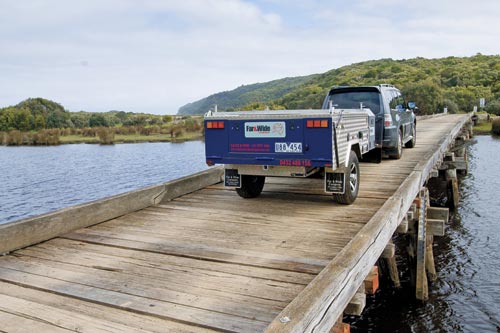


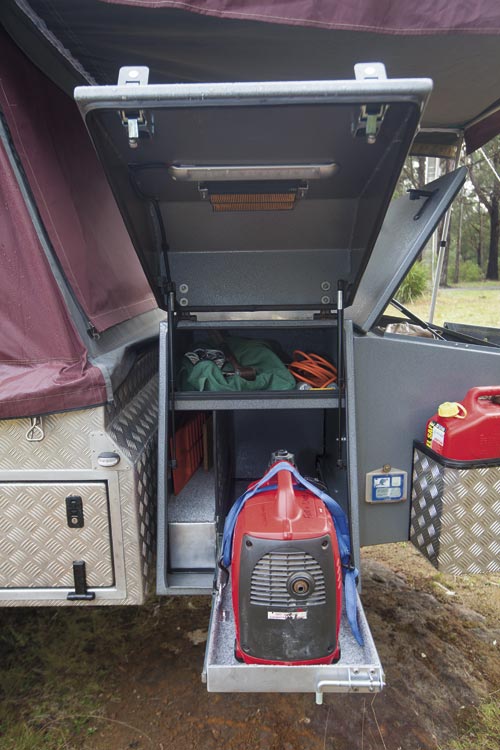
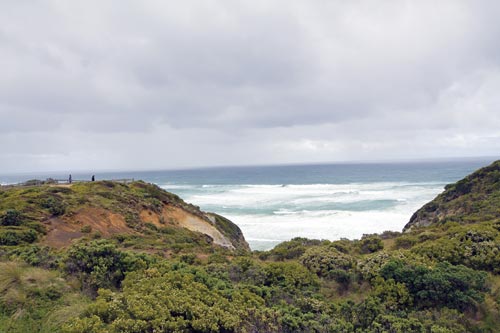
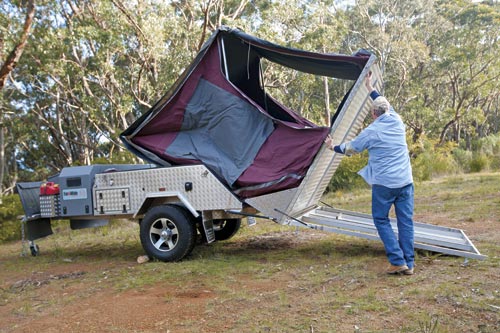
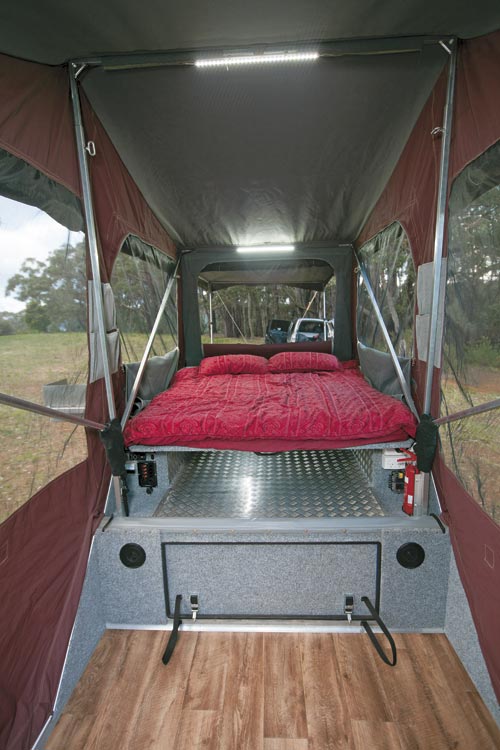
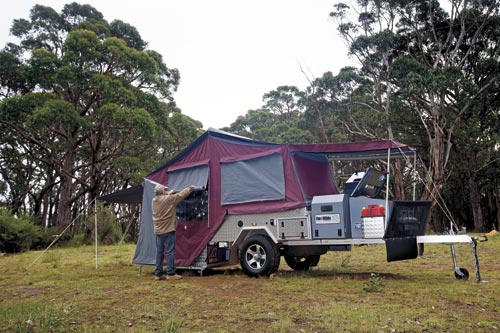
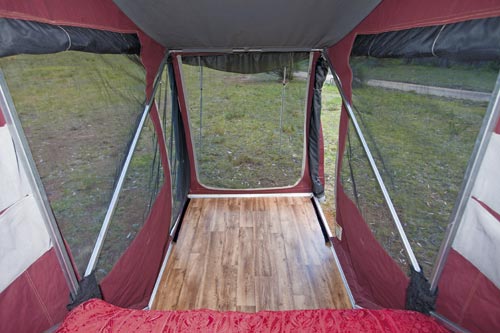
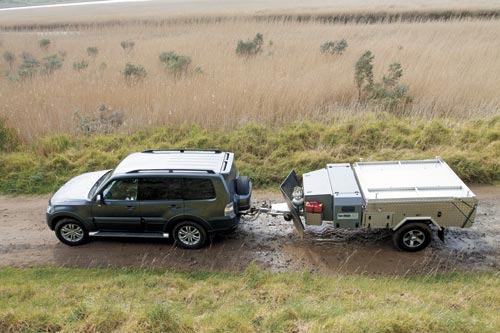
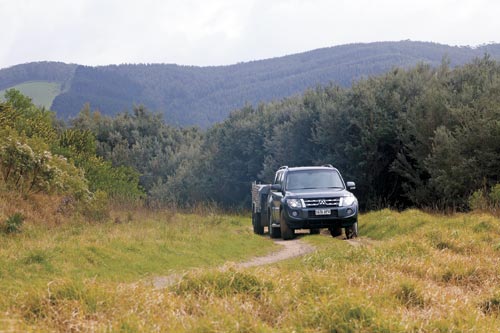

The Simpson in this case is a well built, purposeful and rugged-looking beast that Dave and Cyndi are justifiably proud of.
According to Dave, a fitter and turner by trade who purchased this lifestyle-oriented business five-years ago, their Australian made offroad hard floor camper trailers are renowned for strength, reliability, ease of setup, and excellent dust sealing.
Importantly, Dave and Cyndi are also keen campers themselves - as this magazine goes to print they've just returned from a six-week 10,000km trip to Cape York - which they say provides the sort of essential research and development that keeps their products at the forefront of the industry.
Maintaining a hire fleet also has its benefits in terms of providing a constant stream of feedback on what does and doesn't work.
CAMPER TRAILER
Despite its recent torture test to the Tip, this particular camper looked none the worse for wear, which is always a good sign that things are well designed and durable.
The Simpson is built up from the lower spec Desert Trek, which means it starts life with such essentials like a 12V onboard battery system with charger, hydraulic braking, large under-bed storage area, stainless steel kitchen with four-burner stove and grill, fridge storage and pantry drawer, quality Australian-made tent with 2.4m wide awning, 12V and 240V electrical system, 70L water tank and double jerry can holders.
From here the Simpson adds extra storage including a generator box, solar regulator, external lighting, internal reading lights, upgraded battery system with two onboard batteries, and a stereo system.
It's a sturdy-looking, all-aluminium trailer that sits up high with a purposeful stance that suggests it's ready to tackle anything. The chassis is made of strong (75x50mm) aluminium RHS, with the trailer box (1800x2200mm) finished in five-bar checkerplate polished aluminium. The large front storage box and fridge box finished in a contrasting powder coat aluminium, with the camper's impressive overall appearance set off by a set of attractive CSA alloy wheels, clad with 265/75R16 Savero AT plus tyres.
The drawbar (100 x 50mm aluminium C section) features a hydraulic handbrake, a spirit level to help level the trailer, easy-fold dolly wheel and twin 4kg gas bottles mounted ahead of the large 405L stowage box. The lid of this generously proportioned box lifts effortlessly on gas struts with a powerful LED light mounted inside for illumination. Twin checkerplate jerry-can holders flank the storage box, while the entire front end is protected by a substantial mesh stone guard and thick rubber mud flaps.
A small, easily installed awning that remains permanently attached to the leading edge of the main tent pulls out to cover the fridge area, with two poles and a guy rope securing the installation in a minute or so.
The fridge box itself holds a 50L Waeco or a 40L Engel with a drawer base that rolls out silently and effortlessly on the passenger side of the trailer. The fridge sits on a sturdy base, complete with galvanised metal tie-down hooks to ensure it doesn't move in transit.
Both the fridge box and the generator box on the driver's side of the camper trailer are ventilated and fitted with paper air filters to vent the cavity and prevent dust getting in.
The generator box provides additional stowage for electrical leads, ropes, pegs and other ancillaries, while a smaller additional compartment alongside has space for a washing up bucket and other odds and ends.
Back on the main side of the camper, a pantry drawer below the fridge provides limited storage for crockery, cutlery and condiments, while another small drawer-cum-cubby hole adjacent to the pantry neatly houses the extendable poles for the various flies and annexes.
It's all well organised and precisely engineered, but if there's a small criticism it would be that pantry space is limited, so you will need to store kitchen gear elsewhere.
A four-burner Spinflo cooktop with sink and folding spigot slide out from the trailer body adjacent to the fridge box. The stove, sink and surrounding area are all finished in stylish stainless steel that would fit right in on the set of Master Chef. A quick-clip gas bayonet mounted on the side of the trailer enables the stove to be operating within minutes of stopping.
If that happens to be after dark, a cyclops-like circular LED provides ample illumination for night-time cooking, with switchgear for the 12V water pump and the light tucked discretely away inside the drawer unit.
The stove itself features a folding wind deflector and there's preparation space on the sink top but it's limited, so a cutting board shaped to fit the sink would be handy.
There are 12V and 240V power outlets mounted on the trailer body on the same side as the fridge and stove, with inlets for both on the opposite side.
The front stowage box, fridge box and generator box are all accessed via quality compression locks, with the fridge, stove and generator rolling effortlessly out on low-resistance rollers. Spring-loaded bolts secure the various roller drawers when travelling.
TOWING
We put the Simpson through some tight bush manoeuvres, deliberately seeking to get it crossed up over the steep and slippery humps. In these conditions it followed our Mitsubishi Pajero tow vehicle faithfully, exhibiting no ground clearance or other issues. We also took it down some sandy beach access tracks where it tracked faithfully, its leaf spring and shock absorber suspension handling the potholed and corrugated conditions with ease.
Open road performance was equally impressive, staying tucked in and well behaved at all times behind the Pajero, which handled the 940kg tare weight easily.
UNDER COVER
The Simpson's tent setup is a simple three or four step process, requiring the unclipping of four latches and two spring-loaded bolts before first folding back the aluminium frame atop the trailer. With its four adjustable legs this frame forms the base for the hard floor and, when folded rearwards, helps draw up the tent structure itself. The whole process takes a minimum of muscle and is easily achieved by one person.
The tent and hard floor are fixed to the aforementioned base with two bolts before you adjust the legs at each corner to level things. Once that's done you step in through the side doors to extend the in-situ square bows at either end of the tent and you're done. It really couldn't be much simpler or fuss free. Dave estimates setup time for novices at 10-15 minutes, with the awning, timing which we find plausible.
The tent area itself is a good size (4400x1800mm) with enough space on the main floor area for a couple of camp stretchers if you don't have time or can't be bothered to set up the annexe. A queen size innerspring mattress is set up on the trailer bed itself and can be accessed without the need for a step, while illumination comes courtesy of three well-located LED strips. The latter are placed above the bed head, at the foot of the bed and in the 600L storage cavity below the bed, with a master switch-pad discretely tucked away near the foot and a reading light switch near the head.
The various electric relays, 12V plugs and voltmeter are all installed neatly and unobtrusively near the foot of the bed, alongside a Sony digital radio and MP3 player with twin speakers and a remote control, which is a nice touch. There's a fire extinguisher and four convenience pockets affixed to the canvas walls, plus a channel of space between the edge of the mattress and trailer sides to stow reading glasses, torches and so on.
The tent canvas is quality Dynaproofed Wax Converters, with a 12oz roof and 10oz body. There's ample ventilation courtesy of six windows and two doors, all zippered and gauzed, plus a tropical roof for tropical climes.
There's a small rear awning similar in size to the one that covers the front drawbar, which creates an easy-to-erect covered area that's big enough for a couple of chairs.
SUMMING UP
The $42,500 Simpson sits in the middle of Far & Wide's three model range, flanked by the $38,500 Desert Trek and the $50,500 Tanami Signature.
It's a well designed and impeccably built unit with the sort of high-quality finishes and attention to detail that suggests it will give years of durable service.
We enjoyed our couple of days in The Simpson and would happily haul it to any of our bucket list destinations, safe in the knowledge it's well designed, durable and comfortable enough to be a home-away-from-home for extended periods.
HITS & MISSES
I LIKED
- Stylish good looks
- Quality of build, inclusions, fit and finish
- Attention to detail
- Sturdy design
I WOULD HAVE LIKED
- More food preparation space
- A larger pantry
THE MITSUBISHI PAJERO TOW VEHICLE
We towed The Simpson at close to its 940kg Tare weight using a 3.2L four-cylinder turbodiesel-powered Pajero VRX.
With a tow rating of 750kg unbraked or 3000kg braked, the popular Mitsubishi 4x4 handled the Simpson's modest weight easily.
Dave sees lots of Pajero-driving customers and generally recommends they opt for a 2in lift kit if they're going to be towing regularly, in order to optimise the angle of the vehicle to his high riding camper trailers. In this case we reversed the tow hitch which got the angle close enough for review purposes.
Fitted as it was with standard suspension, the Pajero did sit down a bit at the rear once the trailer was hitched up, but not excessively and the trailer didn't have any significant adverse impact on handling, or steering feel.
In fact, the Mitsubishi offroader felt supremely confident at all times, with good road holding and the handy ability to seamlessly switch from more fuel efficient rear wheel drive to wet weather friendly full-time 4WD while on the run.
The turbodiesel engine's a bit old school compared to some of the other diesels on the market today in terms of throttle response, as well as noise, vibration and harshness, but its outputs of 147kW/441Nm were ample for this assignment.
The engine mates to a five-speed automatic, which is also not state of the art these days but gets the job done without excessive hunting or the need to shift manually for the most part.
The engine does most of its work between 2000-3000rpm, feeling relaxed and comfortable at these revs and holding 100km/h comfortably while towing with plenty in reserve.
Prior to starting this test we recorded an unladen average of 9.7L/100km in mixed urban and freeway driving, which rose to 13.4L/100km after 500km of towing.
The Pajero may be showing its age against some of the more highly fancied SUVs these days, but it remains a tough, durable and impressive vehicle both on and offroad, with a proven ability as a tow vehicle.
It's also a 'fair-dinkum 4x4' with proper low-range transfer case and rear differential lock, which inspired confidence to take the Simpson into wet and slippery areas where we simply wouldn't have gone in a soft roader.
The only real negative we encountered was the side-hinged rear door, which meant the boot couldn't be opened once the trailer was hitched up.




